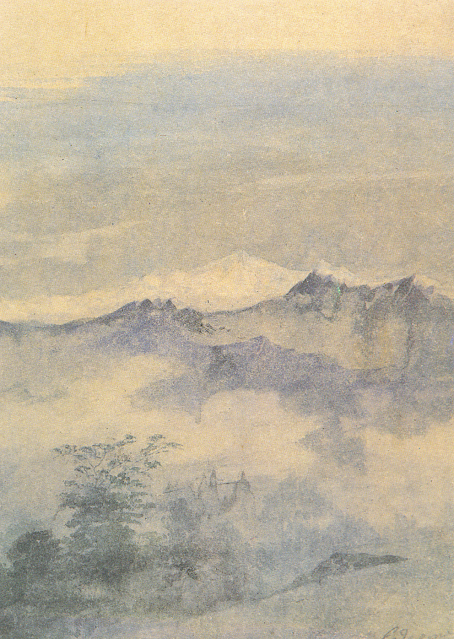In "Remember” from " Country series-Hymalaya", 1924, huile sur toile, Roerich Museum, NewYork
La montagne
L'Everest //Chomolungma/Sagarmāthā (8,848 m - 29,029ft), à droite dans ce tableau, est une montagne située dans la chaîne de l'Himalaya, à la frontière entre le Népal (province de Koshi) et la Chine (région autonome du Tibet).Il est aperçu par des Européens pour la première fois en 1847 puis, après quelques années d'observations et de calculs, il est identifié comme le plus haut sommet du monde. Son altitude est établie à 8 849 mètres. Cette caractéristique lui vaut d'être baptisé de son nom actuel par les Occidentaux en 1865 en l'honneur de George Everest, arpenteur général des Indes orientales de 1830 à 1843, et, dès les années 1920, de susciter l'intérêt des alpinistes qui se lancent à l'assaut de ses faces. Plusieurs expéditions, en particulier britanniques, se succèdent depuis le versant nord au Tibet. Toutefois, les conditions météorologiques extrêmes font leurs premières victimes, parmi lesquelles George Mallory et Andrew Irvine, en 1924, dont on ne saura probablement jamais avec certitude s'ils ont atteint le sommet. En 1950, le Népal autorise l'accès à la montagne depuis le sud offrant des possibilités d'ascension par l'arête Sud-Est, moins périlleuse. Finalement, trois ans plus tard, Edmund Hillary et Tensing Norgay deviennent les premiers hommes à atteindre le sommet de l'Everest. Dès lors, les exploits en tous genres s'enchaînent, alimentant les fantasmes populaires ; mais, en 1996, une série d'accidents mortels vient rappeler les dangers liés à la montagne, portant de nos jours à plus de 200 le nombre de victimes. Pourtant, le tourisme de masse se généralise, fragilisant ce milieu naturel malgré les créations du parc national de Sagarmatha en 1976 et de la réserve naturelle du Qomolangma en 1988. Ainsi, plus de 14 000 alpinistes ont tenté l'ascension depuis 1922 et plus de 4 000 l'ont réussie, bien aidés, pour la majorité d'entre eux, par les porteurs sherpas et l'utilisation de bouteilles d'oxygène.
La plupart des tentatives d'scension sont effectuées aux mois d'avril et mai avant la mousson d'été. À ce moment de l'année, un changement du courant-jet réduit les vitesses moyennes de vent en haute altitude. D'autres tentatives sont réalisées après la mousson aux mois de septembre et octobre mais la neige tombée pendant la mousson et des conditions météorologiques plus instables rendent l'ascension plus difficile.
Les pionniers laissent désormais la place à la génération du business lucratif. Des dizaines d'opérateurs proposent des expéditions jusqu'au sommet moyennant des sommes pouvant approcher les 50 000 à 70 000 dollars. Ces expéditions commerciales devenues la norme durent environ deux mois, transformant les camps de base en véritables villes éphémères. La démocratisation des technologies permettant une acclimatation à domicile, grâce notamment à des tentes hypoxiques, tend à réduire cette durée.
Point de passage obligé de l'itinéraire classique vers le sommet, le col Sud est devenu une véritable décharge. Peu respectueuses de l'environnement, contrairement à ce que l'on pourrait penser, les expéditions y abandonnent matériel et déchets qui réapparaissent à la fonte des plaques de neige. Mandatée par le gouvernement népalais et l'UNESCO, une équipe dirigée par l'alpiniste Pierre Royer a entrepris un grand nettoyage au printemps 1993. Au mois de mai, l'expédition, avec une vingtaine de Sherpas, a redescendu huit tonnes de déchets (bouteilles d'oxygène, plastiques, verres, toiles, etc. Le gouvernement népalais essaye de lutter contre cette pollution : chaque expédition est désormais tenue de prouver qu'elle n'a pas abandonné son matériel, sous peine de perdre une caution de 4 000 dollars. En mars 2014, il annonce qu'à partir du mois suivant, tout alpiniste doit redescendre huit kilogrammes de déchets en plus de son propre matériel, sous peine de poursuites. Le tourisme de masse est le danger qui guette désormais l'Everest surnommé, Le Toit du Monde.
Ecoutez notre podcast
__________________________________________
2024 - Wandering Vertexes / Gravir les montagnes en peinture
Un blog de Francis Rousseau


%20Himalayas,%20c.%201920%20Oil%20on%20board,%2018%20x%2022%20inches,%20%20%20Private%20collection,%20Santa%20Barbara-%20courtesy%20JAmes%20MAin%20Faineart%20s.png)
-%20Nuptse%20%20Himalaya%202011%20%20acrylic%20on%20paper-%20John%20Mitchell.jpg)












